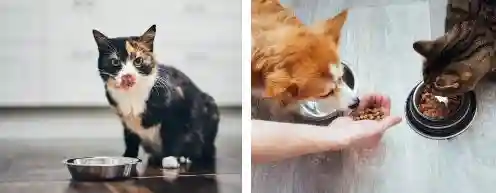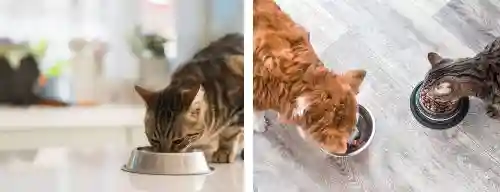When it comes to ensuring the health and happiness of your feline friend, choosing the right diet is paramount. Cats have unique dietary requirements that must be met to ensure they live their best lives. In this article, we’ll walk you through the process of selecting the best diet for cats, providing valuable insights and practical tips to keep your furry companion in top-notch shape.
Understanding Your Best Diet for Cat’s Nutritional Needs
Cats are obligate carnivores, which means they require a diet rich in animal-based protein. Their bodies are designed to thrive on high-quality proteins, such as those found in meat and fish. This ensures they get essential amino acids and other nutrients vital for their overall well-being.
Cats require Animal-Based Protein

Cats are obligate carnivores, which means that their diet should primarily consist of animal-based protein to meet their specific nutritional needs. Here’s some information on the importance of animal-based protein in a cat’s diet:
Cats have unique dietary requirements that set them apart from many other animals. Here’s why animal-based protein is crucial for their well-being:
- Essential Amino Acids: Cats require specific amino acids, such as taurine and arginine, that are abundant in animal tissues. These amino acids are vital for various bodily functions, including heart health and vision.
- High Protein Needs: Cats have a higher protein requirement compared to many other animals. Their bodies are adapted to efficiently use protein for energy, growth, and maintaining muscle mass.
- Taurine: Taurine, found primarily in animal tissues, is essential for cats. A deficiency in taurine can lead to serious health issues, including heart problems and vision impairment.
- Carnivorous Nature: Cats are natural hunters and their digestive systems are designed for processing animal-based proteins. Plant-based proteins are less biologically available to them.
- Quality of Protein: The quality of protein matters. Cats benefit most from high-quality, easily digestible animal proteins, such as those found in meat and fish.
- Avoiding Fillers: Commercial cat foods with excessive fillers like grains or plant-based proteins may not meet a cat’s nutritional needs. It’s important to select cat food that lists animal-based proteins as the primary ingredients.
Choosing Between Commercial and Homemade Cat Diets
There are two main options for feeding your cat: commercial cat food or homemade diets. Each has its pros and cons. Commercial cat foods are convenient and formulated to meet specific nutritional needs, but you should ensure you’re selecting a high-quality brand.
Understanding Cat Food Labels
Understanding cat food labels is crucial to making informed choices. Look for labels that list protein as the primary ingredient. Avoid foods with excessive fillers and artificial additives. Check for a statement indicating that the food meets the standards set by the Association of American Feed Control Officials (AAFCO).
When it comes to deciphering cat food labels and choosing between commercial and homemade diets for your feline friend, there are several important factors to consider. Cat food labels can be quite complex, but breaking them down into key points can help you make an informed decision:
Commercial Cat Food

- Ingredients List:
- Look for a high-quality protein source as the first ingredient (e.g., chicken, fish, or turkey).
- Avoid foods with vague or generic terms like “meat by-products” or “animal digest.”
- Guaranteed Analysis:
- This provides information on the minimum percentages of protein, fat, and fiber in the food.
- Ensure the levels meet your cat’s specific dietary needs, which may vary depending on age and activity level.
- AAFCO Statement:
- Check if the food meets the standards set by the Association of American Feed Control Officials (AAFCO) for complete and balanced nutrition.
- Fillers and Additives:
- Be cautious of foods that contain excessive fillers like corn or wheat, as cats are obligate carnivores and require primarily meat-based diets.
- Avoid artificial preservatives, colors, and flavors.
- Life Stage:
- Select a food appropriate for your cat’s life stage (e.g., kitten, adult, senior).
- Special formulations may exist for cats with specific health concerns.
Homemade Cat Food

- Consult a Veterinarian:
- Before making homemade cat food, consult your veterinarian to ensure it meets your cat’s nutritional requirements.
- Balanced Diet:
- Create a balanced diet that includes the right proportions of protein, fat, vitamins, and minerals.
- Ensure it contains essential nutrients like taurine and arachidonic acid.
- Protein Sources:
- Use high-quality protein sources like lean meats (chicken, turkey, fish) or cooked eggs.
- Avoid raw meat and bones, which can be risky for cats.
- Supplementation:
- Some homemade diets may require supplements to ensure complete nutrition. Your vet can advise on this.
- Hygiene and Food Safety:
- Maintain strict hygiene when preparing homemade cat food to prevent contamination.
- Store and handle ingredients safely.
- Gradual Transition:
- If transitioning from commercial to homemade food, do it gradually to avoid digestive upset.
General Tips for Commercial and Homemade Cat Food
- Consider your cat’s individual needs, including age, activity level, and any health issues.
- Monitor your cat’s weight and overall health regularly.
- Be prepared for trial and error; it may take some experimentation to find the best diet for your cat.
The choice between commercial and homemade cat food depends on your cat’s unique requirements. Also, your willingness to invest time and effort into preparing a balanced homemade diet. Always consult your veterinarian for personalized guidance on your cat’s nutritional needs.
Wet vs Dry Cat Food
Both wet and dry cat food have their benefits. Wet food helps keep your cat hydrated and can be a good option for cats with urinary tract issues. Dry food is convenient, can help with dental health, and may be more cost-effective. A combination of both can work well for many cats.
The choice between wet and dry cat food is an important decision for cat owners, and it comes with its own set of considerations. Here are some key points to help you understand the differences between the two options:
Wet Cat Food

- Moisture Content:
- Wet cat food has a significantly higher moisture content (usually around 75-85%) compared to dry cat food.
- This high moisture content helps keep cats well-hydrated, which is particularly important for cats prone to urinary tract issues.
- Palatability:
- Many cats find wet food more palatable due to its meaty texture and strong aroma.
- It can be a good choice for picky eaters or cats with dental issues who find it hard to chew dry kibble.
- Nutritional Balance:
- Wet cat food can be nutritionally balanced, providing all the essential nutrients your cat needs.
- Always check the label for AAFCO certification to ensure it’s complete and balanced.
- Weight Management:
- Portion control is often easier with wet food, making it a good choice for cats that need to manage their weight.
- Dental Health:
- Contrary to popular belief, wet food can promote dental health by reducing the risk of tartar buildup. Some brands even offer dental care formulations.
- Spoilage:
- Wet food can spoil more quickly once opened, so it’s important to store it properly and use it within a reasonable timeframe.
- Cost:
- Wet cat food is typically more expensive per serving than dry kibble.
Dry Cat Food

- Convenience:
- Dry cat food is convenient to store and has a longer shelf life than wet food.
- It doesn’t require refrigeration once opened.
- Dental Health:
- Some dry cat foods are designed to promote dental health by reducing plaque and tartar buildup through abrasive kibble texture.
- Portion Control:
- It’s easier to control portion sizes with dry food, which can be beneficial for cats prone to overeating.
- Cost-Effective:
- Dry cat food is generally more cost-effective than wet food, especially for multi-cat households.
- Weight Management:
- Special formulations for weight management are widely available in dry cat food options.
- Storage:
- Dry food is easy to store, doesn’t require refrigeration, and is less prone to spoilage.
Considerations for Wet and Dry Cat Food Options
- Cat’s Preference: Your cat’s individual preference should play a role in your decision. Some cats prefer one type of food over the other.
- Health Needs: Consider your cat’s specific health needs, such as urinary tract health, when choosing between wet and dry food.
- Balanced Diet: Ensure that whichever type of food you choose, provides a balanced and complete diet, meeting all of your cat’s nutritional requirements.
- Hydration: If you choose dry food, make sure your cat has access to fresh water at all times to help compensate for the lower moisture content.
The choice between wet and dry cat food depends on your cat’s unique needs, your budget, and your personal preferences. It’s often a good idea to consult with your veterinarian to determine the best choice for your specific cat’s health and lifestyle. Some cat owners even choose a combination of both wet and dry food to provide variety in their cat’s diet.
Special Diets for Special Cats

Some cats have specific dietary needs due to allergies, sensitivities, or medical conditions. Consult your veterinarian if you suspect your cat requires a special diet. They can recommend appropriate options and guide you in managing your cat’s unique dietary requirements. Here are some common special diets for special cats and when they might be needed:
- Prescription Diets:
- These are formulated to address specific medical conditions such as urinary tract issues, kidney disease, diabetes, or obesity.
- Prescription diets are typically recommended by veterinarians and can be crucial in managing chronic health problems.
- Hypoallergenic Cat Diets:
- Some cats suffer from food allergies or intolerances, leading to skin issues, gastrointestinal problems, or chronic ear infections.
- Hypoallergenic diets contain novel protein sources and limited ingredients to reduce the risk of triggering allergic reactions.
- Limited Ingredient Diets:
- Cats with sensitivities or allergies may benefit from diets with fewer ingredients to pinpoint and eliminate potential allergens.
- These diets help simplify the cat’s food and can make it easier to identify and manage food sensitivities.
- Grain-Free Diets:
- While grain allergies in cats are relatively rare, some owners prefer grain-free diets for their pets.
- Grain-free diets often contain alternative carbohydrate sources like peas, potatoes, or sweet potatoes.
- Raw Diets:
- Raw diets consist of uncooked meat, bones, and organs. Some cat owners believe these diets mimic a cat’s natural diet more closely.
- However, raw diets can be controversial and should be prepared carefully to minimize the risk of foodborne illnesses.
- Homemade Diets:
- Cats with specific dietary needs may require homemade diets that are carefully balanced and prepared under veterinary guidance.
- Homemade diets can address individual health concerns but require diligence to ensure proper nutrition.
- Weight Management Diets:
- Cats struggling with obesity may require special diets designed for weight loss.
- These diets typically have reduced calorie content while still providing essential nutrients.
- Senior Cat Diets:
- As cats age, their nutritional needs change. Senior diets are formulated to support aging cats with joint health, cognitive function, and reduced calorie requirements.
- Raw Frozen Diets:
- These diets offer the benefits of raw feeding with the convenience of pre-packaged, frozen portions.
- They can be a safer option than completely raw diets, as they are often pasteurized to reduce the risk of pathogens.
- High-Fiber Cat Diets:
- Cats with constipation or other gastrointestinal issues may benefit from high-fiber diets to promote regular bowel movements.
- Vegan or Vegetarian Diets:
- Some owners choose plant-based diets for ethical or environmental reasons.
- However, these diets must be carefully balanced to ensure cats receive essential nutrients like taurine, which is primarily found in animal-based sources.
Cat Feeding Frequency and Portions

Feeding your cat the right portions at the right frequency is essential to preventing obesity and other health issues. Consult the feeding guidelines on the cat food packaging and adjust based on your cat’s age, activity level, and overall health. Here are some guidelines:
Cat Feeding Frequency
- Number of Meals: Cats are natural grazers, and in the wild, they eat multiple small meals throughout the day and night. Ideally, you should aim for at least two meals per day for your cat.
- Consistency: Try to establish a consistent feeding schedule. Cats thrive on routine, and having set meal times can help regulate their digestion and behavior.
- Kittens vs. Adult Cats: Kittens require more frequent feeding, usually four to six times a day when very young, gradually reducing to three meals per day as they grow. Adult cats can be fed twice a day.
- Senior Cats: Older cats may benefit from more frequent, smaller meals to ease digestion and prevent overeating.
Cat Feeding Portion Sizes
- Read Labels: Follow the feeding guidelines provided on the cat food packaging. These guidelines are usually based on your cat’s weight and activity level.
- Consult with a Vet: Your cat’s veterinarian can help determine the appropriate portion size based on your cat’s specific needs, taking into account factors like age, weight, and any health concerns.
- Monitor Body Condition: Regularly assess your cat’s body condition by feeling its ribs and looking at its overall body shape. You should be able to feel the ribs without pressing too hard but not see them prominently.
- Avoid Overfeeding: Overfeeding can lead to obesity, which can contribute to various health issues. Stick to the recommended portion sizes and avoid free-feeding (leaving food out all day).
- Treats and Snacks: Limit treats and snacks, as these can quickly add extra calories to your cat’s diet. If you give treats, choose small, low-calorie options.
- Special Diets: Cats on special diets, such as weight management or prescription diets, should strictly adhere to the recommended portions provided by the veterinarian.
- Canned vs. Dry Food: Portion sizes may vary between canned (wet) and dry cat food. Wet food contains more moisture and can be less calorie-dense, so you might need to feed a larger volume of wet food to meet your cat’s nutritional needs.
- Transition Gradually: If changing your cat’s diet or portion size, do so gradually to prevent digestive upset. Mix the new food with the old food, increasing the ratio of the new food over several days.
Introducing New Diets Gradually
When transitioning to a new diet, do it gradually to avoid digestive upset. Mix a small amount of the new food with the old food and gradually increase the ratio of the new food over a week or two until your cat is fully accustomed to the new diet.
Monitoring Your Cat’s Health
Pay close attention to your cat’s overall health, weight, coat condition, energy levels, and litter box habits. These indicators can help you assess if the chosen diet is suitable for your cat. If you notice any changes or concerns, consult your veterinarian.
Avoiding Dangerous Foods
Certain foods are toxic to cats and should be avoided at all costs. These include chocolate, onions, garlic, grapes, and raisins. Additionally, some plants can be harmful. Educate yourself on potential hazards to ensure your cat’s safety.
Staying Consistent
Cats thrive on routine, and their diet is no exception. Once you’ve found a diet that suits your cat, stick with it. Consistency in feeding habits can help your cat maintain good health and prevent unnecessary stress.
Balancing Your Cat’s Diet
Even though cats are natural carnivores, relying solely on a meat-only diet might lead to potential deficiencies in essential fatty acids, vitamins, and minerals. This is where commercial diets come into play as they are formulated to provide the necessary nutrients for a well-rounded diet that keeps your feline friend in optimal health.
Eline, a renowned feline nutritionist, emphasizes the importance of a balanced diet. She recommends opting for complete and balanced canned food, ensuring a diet that is both high in protein and low in carbohydrates. This approach not only helps with calorie control but also ensures your cat stays well-hydrated, a vital factor for their overall well-being.
Hydration Matters
One of the major advantages of canned food is its ability to increase water intake, a significant consideration for your cat’s health. Cats that solely consume dry food often consume less water overall, leading to a higher risk of dehydration. This is particularly important for indoor cats, who are prone to health issues such as urinary tract blockages and constipation due to insufficient hydration.
Vets highlight that increased water intake from eating canned food is a practical way to mitigate these risks. It’s a key step in decreasing the likelihood of these problems occurring or reoccurring, making canned food a wise choice for your cat’s diet.
The Pitfalls of Dry Food
Dry food diets, on the other hand, tend to be higher in fat, carbohydrates, and calories, which can contribute to the risk of obesity, especially in indoor cats. Vets point out that dry diets have been linked to obesity and diabetes in cats that live indoors. Since indoor cats often have fewer opportunities for exercise and may have food continuously available, it’s essential to be mindful of their diet.
For the health of your adult cat, it’s recommended to select a canned food with a protein content of at least 40% (greater than 10% if the can contains more than 78% water) and a carbohydrate content of 10% or less. You can also check the ingredients list to ensure that carbohydrates are not among the first five listed, helping you make a more informed choice.
Catering to Individual Preferences
Just like people, each cat has its unique tastes, texture preferences, and dietary needs. Dr. Zoran understands that having multiple cats in one household might present challenges in terms of feeding them the same food. It’s important to consider each cat’s individual needs, life stage, flavor preferences, and even the texture they prefer. Ensuring that each cat has its own designated bowl can help create a balanced and personalized feeding routine.
Occasional Treats and Additions
Beyond their regular canned diet, you can occasionally treat your cat with small pieces of unseasoned, cooked meats or introduce cat grass, which serves as an excellent source of fiber. These occasional additions can provide enrichment and variety, making mealtime enjoyable for your feline companion.
Remember, as a responsible cat owner, staying informed about your cat’s nutritional requirements and consulting with your veterinarian is essential for their well-being. A balanced diet, tailored to your cat’s specific needs, preferences, and life stage, is the key to a happy and healthy feline friend.
Conclusion
Choosing the best diet for your cat is a vital aspect of responsible pet ownership. By understanding your cat’s nutritional needs, selecting high-quality foods, monitoring their health, and staying consistent, you’ll provide your feline friend with a happy and healthy life. Remember, if you ever have questions or concerns about your cat’s diet, consult your veterinarian for professional guidance.
Frequently Asked Questions (FAQs)
Can I Feed My Cat a Vegetarian Diet?
No, cats are obligate carnivores, and a vegetarian diet won’t provide them with the essential nutrients they need to thrive. It’s essential to feed them animal-based protein.
How Do I Know if My Cat Has Allergies to Food?
Common signs of food allergies in cats include skin irritations, gastrointestinal issues (such as vomiting and diarrhea), and excessive scratching. If you suspect food allergies, consult your veterinarian for proper diagnosis and guidance.
Should I Give My Cat Supplements?
In most cases, balanced and high-quality cat food should provide all the necessary nutrients. Giving supplements without veterinary advice may lead to an imbalance. Consult your vet before adding any supplements to your cat’s diet.
Is raw meat a good option for cats?
Raw meat diets can pose health risks, including bacterial contamination. It’s essential to consult with a veterinarian before feeding your cat a raw diet to ensure it’s nutritionally complete and safe.
How Can I Prevent My Cat from Becoming Overweight?
Portion control is key to preventing obesity. Follow the feeding guidelines on the cat food packaging, and avoid giving too many treats. Regular exercise and playtime are also important to keep your cat active.
Can I Free-Feed My Cat?
Free feeding (leaving food out all day for your cat to eat as they please) can lead to overeating. It’s better to establish regular feeding times and control portions to maintain a healthy weight.







Leave a Comment
You must be logged in to post a comment.